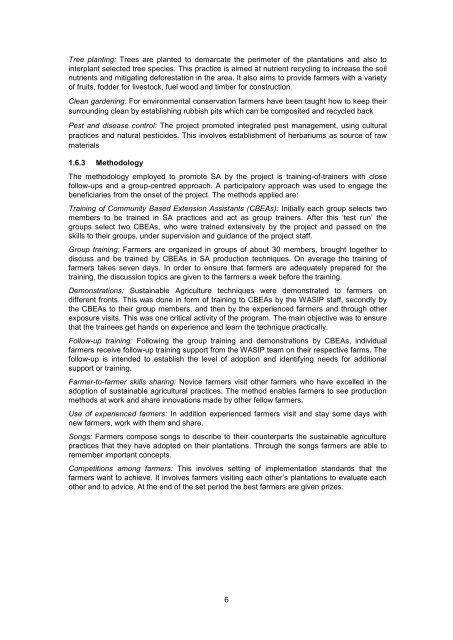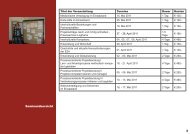Adoption of Sustainable Agriculture Practices in ... - Horizont3000
Adoption of Sustainable Agriculture Practices in ... - Horizont3000
Adoption of Sustainable Agriculture Practices in ... - Horizont3000
Create successful ePaper yourself
Turn your PDF publications into a flip-book with our unique Google optimized e-Paper software.
Tree plant<strong>in</strong>g: Trees are planted to demarcate the perimeter <strong>of</strong> the plantations and also to<br />
<strong>in</strong>terplant selected tree species. This practice is aimed at nutrient recycl<strong>in</strong>g to <strong>in</strong>crease the soil<br />
nutrients and mitigat<strong>in</strong>g deforestation <strong>in</strong> the area. It also aims to provide farmers with a variety<br />
<strong>of</strong> fruits, fodder for livestock, fuel wood and timber for construction.<br />
Clean garden<strong>in</strong>g: For environmental conservation farmers have been taught how to keep their<br />
surround<strong>in</strong>g clean by establish<strong>in</strong>g rubbish pits which can be composited and recycled back<br />
Pest and disease control: The project promoted <strong>in</strong>tegrated pest management, us<strong>in</strong>g cultural<br />
practices and natural pesticides. This <strong>in</strong>volves establishment <strong>of</strong> herbariums as source <strong>of</strong> raw<br />
materials<br />
1.6.3 Methodology<br />
The methodology employed to promote SA by the project is tra<strong>in</strong><strong>in</strong>g-<strong>of</strong>-tra<strong>in</strong>ers with close<br />
follow-ups and a group-centred approach. A participatory approach was used to engage the<br />
beneficiaries from the onset <strong>of</strong> the project. The methods applied are:<br />
Tra<strong>in</strong><strong>in</strong>g <strong>of</strong> Community Based Extension Assistants (CBEAs): Initially each group selects two<br />
members to be tra<strong>in</strong>ed <strong>in</strong> SA practices and act as group tra<strong>in</strong>ers. After this „test run‟ the<br />
groups select two CBEAs, who were tra<strong>in</strong>ed extensively by the project and passed on the<br />
skills to their groups, under supervision and guidance <strong>of</strong> the project staff.<br />
Group tra<strong>in</strong><strong>in</strong>g: Farmers are organized <strong>in</strong> groups <strong>of</strong> about 30 members, brought together to<br />
discuss and be tra<strong>in</strong>ed by CBEAs <strong>in</strong> SA production techniques. On average the tra<strong>in</strong><strong>in</strong>g <strong>of</strong><br />
farmers takes seven days. In order to ensure that farmers are adequately prepared for the<br />
tra<strong>in</strong><strong>in</strong>g, the discussion topics are given to the farmers a week before the tra<strong>in</strong><strong>in</strong>g.<br />
Demonstrations: <strong>Susta<strong>in</strong>able</strong> <strong>Agriculture</strong> techniques were demonstrated to farmers on<br />
different fronts. This was done <strong>in</strong> form <strong>of</strong> tra<strong>in</strong><strong>in</strong>g to CBEAs by the WASIP staff, secondly by<br />
the CBEAs to their group members, and then by the experienced farmers and through other<br />
exposure visits. This was one critical activity <strong>of</strong> the program. The ma<strong>in</strong> objective was to ensure<br />
that the tra<strong>in</strong>ees get hands on experience and learn the technique practically.<br />
Follow-up tra<strong>in</strong><strong>in</strong>g: Follow<strong>in</strong>g the group tra<strong>in</strong><strong>in</strong>g and demonstrations by CBEAs, <strong>in</strong>dividual<br />
farmers receive follow-up tra<strong>in</strong><strong>in</strong>g support from the WASIP team on their respective farms. The<br />
follow-up is <strong>in</strong>tended to establish the level <strong>of</strong> adoption and identify<strong>in</strong>g needs for additional<br />
support or tra<strong>in</strong><strong>in</strong>g.<br />
Farmer-to-farmer skills shar<strong>in</strong>g: Novice farmers visit other farmers who have excelled <strong>in</strong> the<br />
adoption <strong>of</strong> susta<strong>in</strong>able agricultural practices. The method enables farmers to see production<br />
methods at work and share <strong>in</strong>novations made by other fellow farmers.<br />
Use <strong>of</strong> experienced farmers: In addition experienced farmers visit and stay some days with<br />
new farmers, work with them and share.<br />
Songs: Farmers compose songs to describe to their counterparts the susta<strong>in</strong>able agriculture<br />
practices that they have adopted on their plantations. Through the songs farmers are able to<br />
remember important concepts.<br />
Competitions among farmers: This <strong>in</strong>volves sett<strong>in</strong>g <strong>of</strong> implementation standards that the<br />
farmers want to achieve. It <strong>in</strong>volves farmers visit<strong>in</strong>g each other‟s plantations to evaluate each<br />
other and to advice. At the end <strong>of</strong> the set period the best farmers are given prizes.<br />
6






